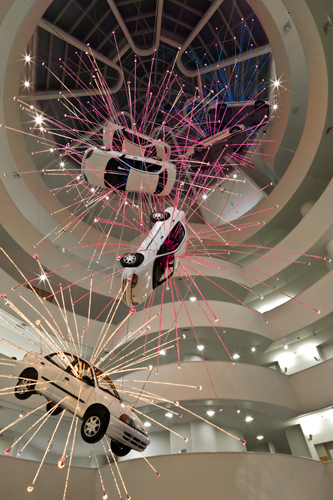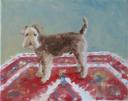Scope, one of the many art fairs going on in New York this weekend, runs through Sunday in a tent at Lincoln Center (10th Avenue at 62nd Street). Galleries from all over Europe, China, South America and the US converge to display emerging contemporary artists. Here are a few of my favorite pieces at the fair:
Antti Laitinen, It’s My Island at Nettie Horn. This London-based gallery has devoted their entire exhibition to the work of this Finnish performance artist and photographer. Laitinen built his own island in the Finish sea by dragging approximately 200 sand bags out into the water and piling them together to form a “landmass”. Three simultaneous videos in the booth show the process of the artist dragging the bags into the water and across the sea and eventually piling them together to form his island. A pile of the actual sandbags rests on the floor beneath the monitors. Six beautiful large-scale photographs document the result of the project, the island, in different light and weather conditions.
Beau Chamberlain acrylic paintings at Project 4 Gallery from Washington, DC. The works are jewel-like when viewed up close with a surface texture reminiscent of English marquetry furniture designs or Italian inlaid colored marble furniture.
Peter Fox paintings at Curator’s Office. Fox uses acrylic paint thickened with a gel medium. The multicolored globs of paint are then applied to a canvas in swathes which look much like handmade Italian marble paper. The texture is rich and thick and creates a three dimensional effect.
New York’s Krampf Gallery is showing a work by Bahk Seon Ghi of a series of burned wood and coal pieces hung with string to form a staircase.
Steinar Jacobsen’s Look Back in Puzzlement II at Oslo’s Galleri K. A group of eighty works, a mixture of green and black photography and painting (oil on aluminum), surround you as you enter this exhibition. The urban street scenes, snapshots taken at night, glow green around the viewer. This is a single, encompassing work and measures approximately 12.5 x 19.5 feet.
Michael Laube at Berlin’s Kuckei + Kuckei. Laube creates works comprised of three glass panels, mounted one in front of the the other with a few inches between them, each decorated with colorful acrylic paint. The horizontal piece is then wall-mounted. As a result of the layering of colors, lines and patterns the pieces seem to change when you look at them from varying angles.
Photo of Michael Laube’s work from Kuckei+Kuckei.



 How does one go about commissioning a work of art?
How does one go about commissioning a work of art?